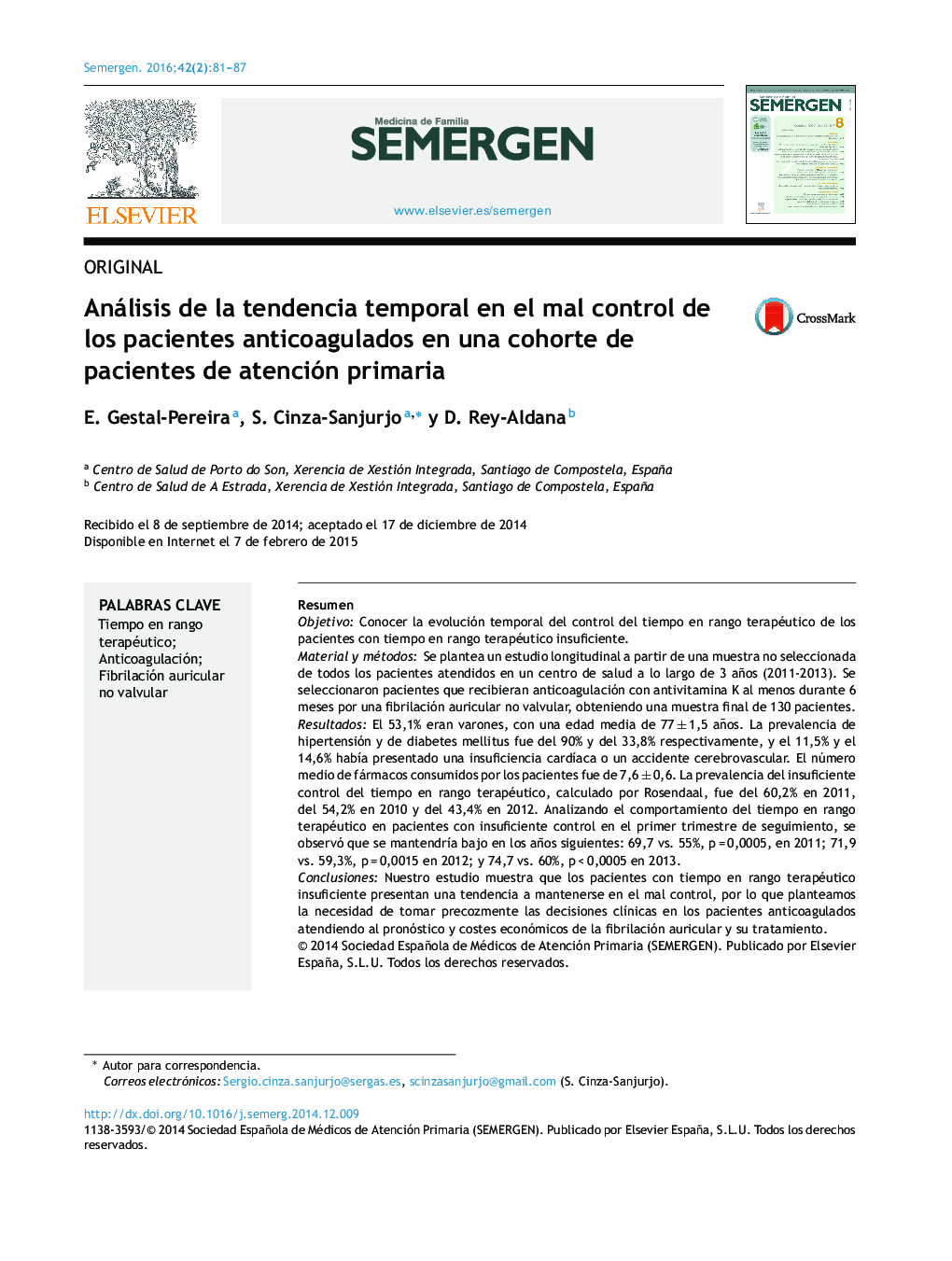| کد مقاله | کد نشریه | سال انتشار | مقاله انگلیسی | نسخه تمام متن |
|---|---|---|---|---|
| 3834501 | 1247317 | 2016 | 7 صفحه PDF | دانلود رایگان |

ResumenObjetivoConocer la evolución temporal del control del tiempo en rango terapéutico de los pacientes con tiempo en rango terapéutico insuficiente.Material y métodosSe plantea un estudio longitudinal a partir de una muestra no seleccionada de todos los pacientes atendidos en un centro de salud a lo largo de 3 años (2011-2013). Se seleccionaron pacientes que recibieran anticoagulación con antivitamina K al menos durante 6 meses por una fibrilación auricular no valvular, obteniendo una muestra final de 130 pacientes.ResultadosEl 53,1% eran varones, con una edad media de 77 ± 1,5 años. La prevalencia de hipertensión y de diabetes mellitus fue del 90% y del 33,8% respectivamente, y el 11,5% y el 14,6% había presentado una insuficiencia cardíaca o un accidente cerebrovascular. El número medio de fármacos consumidos por los pacientes fue de 7,6 ± 0,6. La prevalencia del insuficiente control del tiempo en rango terapéutico, calculado por Rosendaal, fue del 60,2% en 2011, del 54,2% en 2010 y del 43,4% en 2012. Analizando el comportamiento del tiempo en rango terapéutico en pacientes con insuficiente control en el primer trimestre de seguimiento, se observó que se mantendría bajo en los años siguientes: 69,7 vs. 55%, p = 0,0005, en 2011; 71,9 vs. 59,3%, p = 0,0015 en 2012; y 74,7 vs. 60%, p < 0,0005 en 2013.ConclusionesNuestro estudio muestra que los pacientes con tiempo en rango terapéutico insuficiente presentan una tendencia a mantenerse en el mal control, por lo que planteamos la necesidad de tomar precozmente las decisiones clínicas en los pacientes anticoagulados atendiendo al pronóstico y costes económicos de la fibrilación auricular y su tratamiento.
ObjectiveTo determine the temporal trend in poorly-controlled anticoagulated patients.Material and methodsA longitudinal study was conducted on a non-unselected sample of all patients seen in a health centre over a period of 3 years (2011-2013). Patients who received anti-vitamin K anticoagulation for at least 6 months due to non-valvular atrial fibrillation were selected, obtaining a final sample of 130 patients.ResultsThe mean age of the sample was 77.0 ± 1.5 years and 53.1% were male. The prevalence of hypertension and diabetes mellitus was 90% and 33.8%, respectively, and 11.5% and 14.6% had had heart failure or a stroke, respectively. The mean number of medications taken by patients was 7.6 ± 0.6. The prevalence of insufficient control of time in therapeutic range, calculated by Rosendaal, was 60.2% in 2011, 54.2% in 2010, and 43.4% in 2012. On analysing the time in the therapeutic range in patients with impaired control in the first quarter of follow-up, it was observed to remain low in subsequent years: 69.7% vs 55%, P = .0005, in 2011; 71.9% vs 59.3%, P = .0015 in 2012; and 74.7% vs 60%, P = .0005 in 2013.ConclusionsOur study shows that patients with inadequate time in therapeutic range have a tendency to stay in poor control, suggesting the need for early clinical decisions in patients on anticoagulants, taking into account the prognosis and economic costs of atrial fibrillation and treatment.
Journal: SEMERGEN - Medicina de Familia - Volume 42, Issue 2, March 2016, Pages 81–87